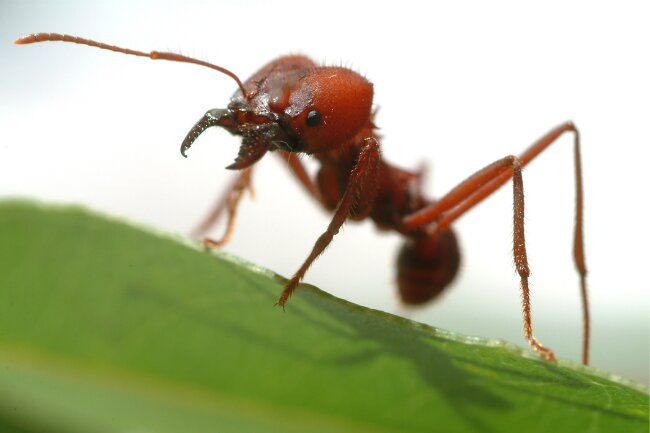Caterpillars breathe through nine pairs of spiracles, small holes in their exoskeleton, located along their bodies. They do not have lungs, instead, the air enters into the spiracles by the force of air pressure.
Contents
Take a breath
Take a deep breath. Though it may feel as natural to us as… well breathing, there’s a whole lot of complicated mechanics coming into play here, helping to feed your body with all-important oxygen.
Oxygen is one of the building blocks of life, it helps us to get energy from our food and is important in the creation of proteins and new cells. Almost all animal life relies on oxygen and therefore needs to breathe in some way or other.
If you’ve been holding that breath, then firstly well done, secondly, you can let it out now. As you breathed in, you will feel your chest expand, and on breathing out it will fall again. This is down to a group of muscles that contract and create a vacuum in your lungs, pulling air in, and then relaxing causing the lungs to collapse again, letting air out.
| Component | Description |
|---|---|
| Spiracles | Small openings on the caterpillar’s body through which it breathes |
| Tracheae | Tiny tubes that connect the spiracles to the internal tissues of the caterpillar |
| Spiracular Glands | Glands associated with the spiracles that help regulate gas exchange |
| Air Sacs | Structures within the caterpillar’s body that store and distribute oxygen |
The entrance for air into the lungs is through your mouth and nose. Once inside the lungs, the air is able to enter into blood cells which carry it around the veins and arteries that travel throughout your body, delivering it to muscles and organs.
This method of breathing may seem the most obvious, however, the majority of animals do not use it. Within other mammals, reptiles and amphibians we are used to finding a pair of lungs, and a mouth and nose connected to them, yet when we look at insects, who rather outnumber us, their method of breathing is entirely different.
Also read: Is a Caterpillar an Insect? (Explained)
A bug’s breath

Firstly, insects do not have lungs. This system of introducing oxygen into the body simply doesn’t scale down well. Another surprising thing is that insects do not have noses, though some might have protrusions that look rather like noses. Neither do they breathe through their mouths?
The alternative that insects have developed are spiracle. Spiracles are small holes in the exoskeleton of the insect. These holes then connect to tube-like structures known as trachea, which branch down till they directly feed air into the insect’s organs and muscles.
In this system, the oxygen isn’t transported by the blood, meaning the insect blood doesn’t contain the haemoglobin that allows this to occur.
Insect blood circulates in a very different way, being an open system. In this system, blood enters a long tube within the body that contains the heart and is then pumped into the insect’s body cavity, where it slowly circulates as the pressure of more blood is pumped in pushes it forward.
This slow method of blood circulation means it would be difficult to get enough oxygen to the places that required it in time.
The waste gases are also released through the spiracles, which effectively serves the same process as us breathing in and out.
Also read: How Does a Grasshopper Breathe? (Explained)
A caterpillar’s breath

Caterpillars are eating machines, and therefore need plenty of oxygen to power them through their various growth spurts. For this reason, their spiracles are relatively big, allowing lots of air in.
Like other insects, caterpillars don’t actively breathe, however, the movement of their bodies force air in and out of the openings.
| Stage | Description |
|---|---|
| Inhaling | The caterpillar contracts its body, drawing air into the spiracles |
| Oxygen Exchange | Oxygen diffuses through the tracheae and is transported to body tissues |
| Carbon Dioxide Release | Carbon dioxide produced by cellular respiration is released through spiracles |
| Exhaling | The caterpillar relaxes its body, allowing the air to be expelled |
Most caterpillars have around nine pairs of spiracles, generally one pair on the thorax and 8 on the abdomen. The abdomen is typically divided into 8 segments, meaning there is usually one pair per segment.
Like some other insects, caterpillars can contract muscles to open and close the spiracles. This can help reduce the loss of moisture when needed.
Also read: Ants Breathing Explained… How do Spiracles Work?
How do caterpillars breathe in the chrysalis/cocoon?

The caterpillar’s spiracles stay with it through its life, both when it becomes a chrysalis and as an adult.
While the chrysalis is the body of the caterpillar, some species weave cocoons around their chrysalis to provide further protection. The cocoon isn’t airtight, though, so oxygen can still reach the caterpillar inside.
The spiracles on the outside of the chrysalis are visible, however, they are comparatively small, with those of the caterpillar typically being much bigger. This is because the caterpillar is no longer eating, so requires less oxygen to convert food to energy.
The final stage for this chrysalis is for an adult butterfly or moth to emerge. The spiracles are then located on the body of the adult. Flying is a very energy-hungry pass time, meaning they too need a good gulp of fresh air to keep ongoing.
Also read: How Does a Caterpillar Make a Cocoon? (Explained)
Breathe easy
Oxygen is an important ingredient to most life, and while the caterpillar’s method may appear to be very different from our own, it certainly gets the job done. Unfortunately, their system would not be suitable for creatures of our size, with air pressure simply not being enough to force the oxygen deep enough into our bodies. Good thing we have lungs instead.

